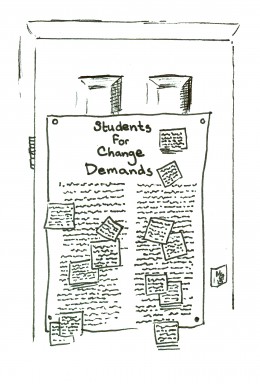
At the end of last semester, Students for Change released a list of demands it wanted the administration to address. This semester, the group’s protests, demonstrations and meetings with the administration have placed it firmly in Binghamton University’s spotlight, and the Editorial Board has decided to put the demands themselves under the same scrutiny. Students for Change has split its demands in to two categories: long-term and short-term. Here, the Editorial Board addresses some of the long-term ones.
One of the group’s biggest priorities is that “overall, Binghamton University’s Cultural competency training needs to be updated.” This is simply too vague. The group has repeatedly claimed that members of the administration, such as Valerie Hampton, are not “culturally competent.” And though group members may have very valid grievances to back up their claims, they must issue a formal definition for cultural competency. Many of their other demands involve cultural competency, and the University can’t move forward in this discussion without knowing for what definition Students for Change is advocating.
We are a group who has taken a cultural competency class offered by this University. Feedback from the staff was mixed, but overall, many of us found it lacking. If this is the kind of course in which they want all students, and most faculty, to participate, we don’t see the benefit. What would a cultural competency GenEd look like? We think it would be most effective to narrow the scope of the classes that qualify for a pluralism credit to ones that truly discus historic oppression or power structures. Intro to American Politics does little to expose new students to the underlying systems of discrimination in society.
Another point of ambiguity in this discussion is the role of the Office of Diversity, Equity and Inclusion (ODEI). At the meeting with President Harvey Stenger, students and faculty took issue with the office and Hampton, its director. To many of the points, Stenger said that the issues concerned the Dean of Students office, not ODEI, even though many students seems to have heard otherwise. ODEI is a new office, so it makes sense that it hasn’t yet grafted perfectly onto the University’s preexisting bureaucracy, but it’s now a priority to clarify the office’s precise role and boundaries.
Students for Change has demanded that the University hire more faculty and staff by 2020 who are queer and transgender, as well as of color. They demand that 50 percent of faculty and staff, as well as of the campus population, be underrepresented minorities within five years’ time.
The basic reasoning behind this demand is logically sound. The student and faculty demographics do not match those of New York state. African-American students make up a mere 5.7 percent of Binghamton’s student body. Only 10.7 percent of Binghamton students are Hispanic. Clearly, not enough is done to attract the best and brightest minority students.
That said, the 50 percent goal proposed is unfeasible and based on inaccurate demographics. Based on 2013 numbers, 18.4 percent of New York state residents are Hispanic or Latino, 17.5 percent are African-American and 71 percent are white. Though substantial, these numbers are not close to the 50 percent figure touted by Students for Change. Binghamton offers in-state tuition to all New York state residents, not simply those from New York City. Any quota proposed by the group must reflect accurate demographic percentages for the entire state, not simply for parts of it.
The University should, however, aggressively recruit from high schools large percentages of minority students, and perhaps allocate more scholarship money to minorities. Recruitment must be a gradual process. We can’t expect the University to significantly change these numbers by 2020, but goals can be set to increase the number of enrolled minority students each year. The larger percentage of minority students, the more welcoming an environment Binghamton University appears to prospective students of color. Maybe the reason minority students opt to attend other schools is because they perceive the community as small.
Another of these demands is that Binghamton hire a sufficient number of minority faculty members that they represent 50 percent of that population. This is not unattractive, but is practically implausible. Defining minority reductively as blacks and Hispanics, numbers simply fall out of favor for this proposition. Only 8 percent of those awarded Ph.D.s in 2008 — the latest data set available from the National Science Foundation — identified as black or Hispanic. Of all the institutions hiring faculty, and all the institutions likewise wishing to better represent minority populations, Binghamton does not have the most to offer. Binghamton does not have the most funds, the best geographic location, the best weather, etc. The University may have all the intention of hiring as many minority faculty members as possible, but these unfortunate realities limit any institution’s ability to realize such goals.
What Binghamton does have the ability to do, and does to some extent already do, is alter those numbers. A Ph.D.-granting research institution itself, Binghamton can do more than just encourage its undergraduates to enter academia. The University can focus on recruiting more minority students to its own doctoral programs and devote more resources to fund these candidates. Binghamton already offers the Clifford D. Clark Diversity Fellowship for graduate students, which provides funding to members of underrepresented groups and students who come from diverse backgrounds. While we may be limited by a small number of minority applicants, we can do our part as a university to increase the pool of minority Ph.D.s for either us or other universities to hire as faculty.


